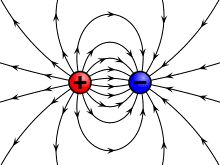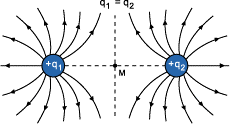
Force Field / Electric Field
Every charged particle produces an electric field around itself which can be elucidated/described by bringing another charge near it. When another charged particle is brought in such a field then it experiences a force whether attractive or repulsive depending upon the types of charges.
If the magnitude of the charge is large, it produces a huge electric field and if the magnitude of the charge is small, it produces a puny electric field.so force field is ‘the region around charged particle within which it exerts a force on the other charges ’. Or a force field is a region where a charged particle (such as an electron or proton) experiences a force (an electrical force) without being touched.
The concept of the electric field was firstly introduced by MICHAEL FARADAY and according to him “it is the intrinsic /basic property of nature that an electric field exists around an electric charge.”
Like gravitational force (the force of attraction b/w all masses in the universe) the origin of electric force (the force that exists b/w electric charges) is also unknown and hence they are called the basic forces of nature.
Electric Field Intensity
Whenever a test charge(a charge with a very small magnitude that placing it in an electric field of the other charge has a negligible effect on that field) is brought into an electric field of the other charge, it experiences a force. like charges(positive-positive or negative- negative) repel each other while unlike charges (positive-negative or negative-positive) attract each other.electric field intensity actually measures the magnitude of this force.so electric field intensity can be defined as
The magnitude of electric force experienced by a test charged particle which is placed at a point within the electric field of another charged particles called electric field intensity.

Electric field intensity is denoted by E ⃗ its equation can be written as
- E ⃗=F/q
Electric field intensity is a vector quantity.it means that it has both magnitude and direction. Its direction is the same as that of electric force.
The standard unit if electric field intensity arises from its definition as it is defined as force per unit charge particle.so its unit would be force unit divided by charge unit. since the unit of force is Newton and charge is coulomb so the unit of electric field intensity is Newton/Coulomb (NC -1) which is equivalent to volt/meter (v/m).while in CGS(centimeter-gram-second) system the electric field intensity is expressed in units of dynes/electrostatic unit (esu) which is equivalent to statvolts/centimeter.
Explanation
Consider a source charge q (which has produced an electric field around itself) and a test charge q˳ which is placed in the electric field of source charge. The strength of the electric field depends upon the source charge, not on the test charge.so according to Coulomb’s law, the test charge will experience a force which can be written as
- F ⃗= K qq˳/r2………… (1) Where q=source charge and q˳=test charge
And as the electric field intensity is
- E ⃗=F/q˳……………….. (2)
Putting the value of F in equation (2)
- E ⃗= (K qq˳/r2). 1/q˳
- E ⃗=K q/r2
Dependence of Electric Field Intensity
The electric field intensity depends upon the following factors
- The magnitude of charge.
- Distance b/w the charges.
- Medium b/w the charges.
Problems Related to Electric Field Intensity
Problem NO.1
A point charge -8.0×10-12 c is placed at the origin. Calculate electric field at a point 2.0 m from the origin on the z-axis.
- Answer= (-1.8×10 -2 ) NC -1
Solution
Given data;
- Point charge=q= -8.0×10 -8c
Distance from charge=r=2.0m
To find;
Electric field intensity=E ⃗=?
Sol;
As electric field intensity=E, ⃗= k q/r2
Putting the given values
E ⃗=9×109(-8×10-8)/ (2)2 k ̂
E ⃗= ( -1.8×10 2 k ̂ ) NC -1…………………. answer
Problem NO. 2
What is the strength of electric field 0.16m on a positive charge of 6.7mc?
Answer=2.4×106 N/C
Solution;
Given data;
q =6.7mc
r=0.16m
K=9×109
To find;
Electric field strength=?
AsE ⃗ =K q/r2
Putting the given values
E ⃗=9×109 (6.7×10 -6)/ (0.16)2
E ⃗=2.4×106 N/C………………… answer
Electric Lines of Forces
Every charged particle produces an electric field around itself. Michael Faraday firstly described the representation of the electric field in the form of lines which is called an electric field of lines or electric lines of forces.it can be defined as
The visual representation of the electric field in term of lines. OR
The path followed by a unit positive charged particle which is placed at a point within the electric field.
- When a unit positive charged particle is placed in an electric field, it is pushed. The direction depends upon the type of source charge. If the source charge is positive then the unit positive charge is pushed in an outward direction. And if the source charge is negative then the unit positive charge particle is pulled in an inward direction.it means that the electric lines of force of positive charge are radially outward while that of negative charge is radially inward.
- An electric field can be represented diagrammatically as a collection of lines with an arrow on. The arrow represents the direction of electric lines of force which is in an outward direction in case of positive charge and inward direction in case of negative charge.
- The strength of the electric field is directly proportional to the length of electric lines of forces. And electric field strength decreases as we move away from the charge.
- Electric lines of force can be used to describe the electric field around charge or system of charges in a better way.
- The electric lines of forces of a single charge end at infinity while electric lines of force b/w two opposite charges starts from positive and ends in negative.
- The electric lines of force cannot pass through the conductor (the materials which have a large number of free electrons in their conduction band) while can easily pass through insulators (the materials which have no free electron in their conduction band).
- The electric lines of force are parallel and equally spaced where the field is strong but are non-parallel where the field is a week.
- The lines are closer where the field is stronger and are farther where the field is weaker.
- The tangent to line at any point gives the direction of the electric field at that point.
- No two lines can cross each other because E ⃗ has only one direction. If they cross then E ⃗ will have more than one direction which is not possible.

The electric field of lines of a negative point charge is directed inward.

An electric field of lines of a positive point charge is directed outward.

The electric field of lines of two opposite charges of equal magnitude starts from positive and ends in negative.

An electric field of lines of two positive charges of equal magnitude is curved.

The electric field of lines of two oppositely charged parallel plates start from positive plate and end in a negative plate.
Related: Coulomb’s Law Rules & Explanations
I hope the article was helpful if you have any question related to the article, please comment it using the comment section below.
